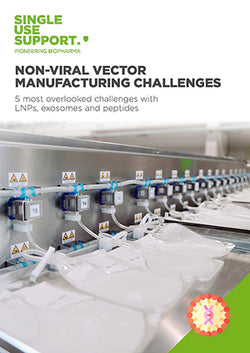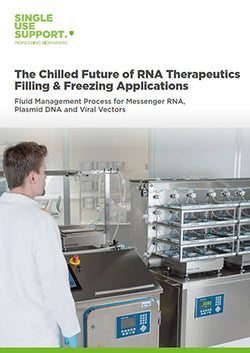Lipid nanoparticles: All you need to know about LNPs
Lipid nanoparticles (LNPs) are nanoparticles that consist of solid and liquid lipids and are stabilized by emulsifiers. They are efficient drug delivery systems which carry drug substances to target cells, where they become absorbed and are released.
After the first LNPs were approved by FDA in 2018, the whole field of LNPs as drug delivery systems has expanded rapidly. They are used in vaccine development (most famously in Covid-19-vaccines that use RNA vaccine technology), in different cancer therapeutics, gene therapy and genome editing.
In the following we will explore what qualifies lipid nanoparticles as one of the most promising pharmaceutical drug delivery systems and will take a closer look at their structure, applications and challenges connected with the LNP manufacturing process.
What are lipid nanoparticles?
Lipid nanoparticles are spherical vesicles which consist of solid and liquid lipids and are stabilized by surfactants (emulsifiers). Their size ranges from 10 to 1000 nanometres.
What distinguishes LNPs from other lipids used in common liposome technology, is their composition. Lipid nanoparticle formulations can consist of phospholipids, cholesterol, polyethylene glycol or PEGylated lipids and ionizable lipids and cationic lipids.
The perfect mixture of liposoluble and water-soluble lipids forms nanoparticles that are able to encoat plasmid DNA, RNA, specific drugs or payloads. LNPs act as their protection system in order to deliver them to the cells where they are needed.
Due to their size and composition, lipid nanoparticles can easily be absorbed by human cells, whose membrane also consists of lipids. Once the cell membrane has been penetrated, the lipid bilayer is decomposed and the drug released. This combination of LNPs and payload is also referred to as drug delivery system or nanomedicine.
There are two kinds of nanoparticles, namely solid lipid nanoparticles which show an ordered, crystalline structure and nanostructured lipid carriers with an unstructured matrix. During their formation, the hydrophobic and hydrophilic parts of the lipids self-assemble. In comparison, nanostructured lipid carriers have shown a higher uptake ability than solid lipid nanoparticles.
Advantages over previous lipid-based nucleic acid delivery systems
The use of lipid nanoparticles as transport systems for nucleic acid encoding certain genetic information solved the problem of previous lipid-based carrier systems like polymers and protein derivatives. They are able to encapsulate nucleic acid most efficiently and show potent transfection rates.
Further, through receptor optimizations on the surface, targeting qualities of LNPs improved the intracellular gene delivery to the cytosol. As cellular uptake is higher and encapsulation efficiency is increased, T cells show a more pronounced immune response.
Compared to viral carriers, lipid nanoparticles show low cytotoxicity and immunogenicity.
Read more about Pros & Cons of LNPs for mRNA delivery [[1]]
History of LNPs
The first development that led to LNPs as the drug carrier systems we know today, was the discovery of liposomes in 1965. Liposomes were the earliest nanomedicine delivery platform and are able to transport hydrophobic as well as hydrophilic molecules like proteins or nucleic acids. The advances in LNP development are deeply connected to new advances in mRNA technology. Over the years, different liposomal drug formulations were approved by the FDA.
Solid lipid nanoparticles and nanostructured lipid carriers evolved as the next generation of LNPs with improved physical stability and targeting abilities. Due to their enhanced qualities, they are used in the treatment of many different diseases and have been applied to a number of other fields, as well.
LNP applications
What are lipid nanoparticles used for
Where are LNPs used? Solid lipid nanoparticles have several promising applications in drug delivery, clinical development and have shown great benefits for bio research purposes. Due to their versatility lipid nanotechnology has emerged as a rapidly growing field. Let’s take a closer look at the different applications of LNPs in medicine and other fields of interest.
LNPs in mRNA vaccines
Since Onpattro, the first small interfering RNA (siRNA) LNP gene therapeutic designed to treat transthyretin-mediated amyloidosis, has been approved by the Federal Drug Association (FDA) in 2018, the research and development of LNPs for mRNA delivery has increased rapidly.
There are several mRNA delivery vehicles in development and in clinical trials at the moment. The successful use of LNPs in the Pfizer-BionTech and Moderna Covid-19 vaccines may be the best-known application of LNPs as vehicles for the delivery of mRNA since the Sars-Cov-2 pandemic.
The way they work is that mRNA corresponding to a viral protein is delivered to cells in order to trigger an immune response and lead them to produce antibodies.
The use of LNPs as delivery systems has become necessary, because of RNA’s instability. When used in mRNA vaccines, LNPs form lipid bilayers in which therapeutic cargo can then be encapsulated. Through target specific ligands on the LNP surface, the nanoparticle systems can deliver RNA directly to the cell. Once absorbed, the immune response is triggered and the mRNA is broken down in the cytoplasm. It does not enter the nucleus. Compared to other carrier systems like viral vectors, lipid nanoparticles cause less side effects because they are less immunogenic. Read more about non-viral vectors in the article: Non-viral vectors in gene therapy: LNPs in the spotlight [[2]] [[3]]

LNPs in cancer therapy
Another application of LNPs as drug delivery systems is in antitumor therapy where they are prominently used in the treatment of breast cancer, ovarian cancer and lung cancer among others. By encapsulating anticancer agents and protecting them from degrading in the bloodstream, they are able to enhance the efficiency of the drug.
Further, they can be modified by using targeting ligands like antibodies or peptides that recognize the surface of cancer cells and deliver the cytotoxic payload where it’s needed with less risk of damaging healthy cells in the process. Once they have reached the cell, the drug delivery system is then absorbed via endocytosis and the release of the payload is enabled through endosomal escape. [[4]]
Further areas of application
Next to their revolutionary role in mRNA vaccines, gene therapy and cancer therapy, lipid nanoparticles can also be found in different other fields. They are used as delivery systems in sectors like cosmetics to enhance the efficacy and stability of certain ingredients and are used for targeted delivery of different substances in the food industry and agriculture, where LNPs are used for crop protection. [[5]]
LNP manufacturing
New therapeutics must meet several criteria before they can be marketed. To fulfill all the required regulations can be a challenge. And to adjust and optimize a “running system”, meaning established production methods, once they’ve proved themselves to work, is often not attempted because of the imposed risks that come with such an undertaking.
Batch and continuous manufacturing are the two established methods. Batch is a safe haven for many developers and regulators in the biopharmaceutical industry, although it might be less efficient than continuous manufacturing processes. Continuous manufacturing processes allow for high control and scalability as they usually involve smaller volumes that have to be monitored, compared to batch-manufacturing.
Continuous control through new process analytical technologies (PATs) results in a higher control over unwanted reactions. Further, end-to-end manufacturing would be beneficial for mRNA-LNPs to avoid bottlenecks and make the whole operation more cost effective. However, the numerous steps are usually not carried out in production space, but several.
These are the different steps involved in mRNA and LNP manufacturing:
- Lipid component preparation (emulsion-solvent evaporation or solvent diffusion)
- Aqueous phase preparation
- Mixing (through extrusion, sonication and homogenization through high-pressure)
- Purification
- Concentration
- Formulation
- Fill/finish
- Quality control
Are lipid nanoparticles toxic?
Lipid nanoparticles have been established as very effective drug delivery systems. However, there have been concerns in the past regarding their toxicity for patients. As LNPs are relatively new, there are many cases where more clinical assays are needed to better understand the interaction between LNPs and other ingredients in synthesis.
Although they are considered harmless in most cases, there are factors like chemical composition and surface property characterization as well as particle size which need to be considered. Further, in vivo conditions could in some cases alter the efficacy of an LNP drug, as they have the potential to behave differently in vitro.
Tests with cationic lipids with positive charges have shown that they have the potential of altering bioactive components in the gastrointestinal tract and can lead to inflammations and increased liver enzymes release. Although lipid nanoparticles are considered to be safe, a case to case evaluation of new lipid compositions is necessary.
For those involved in the manufacturing process, LNPs are widely safe. Nevertheless, lipid nanoparticles must be kept stable and sterile, so automated processing with closed systems and temperature control is strongly recommended.
Read more in the article about Lipid nanoparticles toxicity: What to consider? [[6]]
Safe handling of lipid nanoparticles
Manufacturing lipid nanoparticles can be complex and challenging. Specialized equipment and state-of-the-art technology are not only a must, but the production chain must also meet certain regulations to ensure consistent quality and scalability. LNP formulations are sensitive substances and certain precautions have to be made during manufacturing and transport, to ensure a high quality product. Whereas traditional production methods often require a lot of additional manual process steps, single-use technologies streamline the process and make it more time- and cost-efficient.

Aseptic filling of LNPs
Considering the importance of the quality of the drug and the safety of the patient, precautions should be taken to prevent contamination. It should be every manufacturer's ambition to perform filling and aliquoting LNPs in compliance with current good manufacturing practices (cGMPs) including Annex 1 revision.
The fully automated aseptic filling system RoSS.FILL was designed by Single Use Support to minimize contamination risk. Thanks to the platform's modularity it provides a high level of process flexibility and scalability. The use of single-use bioprocess containers and their automated filling in closed, sterile systems ensures the highest safety and quality standards.
Freezing LNPs
Freezing LNP-mRNA therapeutics is necessary to prevent deterioration during cold chain storage and transportation. To ensure stability and viability of protein structures, controlled, fast and even freezing and thawing is part of a successful manufacturing chain.
LNPs in single-use bags are safely transported, frozen down to -80 degrees Celsius and stored in protective single-use shells. The secondary packaging enables advanced plate-freezing. In comparison to common freezing methods, plate-freezing allows for a controlled cooling and an even temperature distribution.
Outlook in the field of LNPs
Their many advantages have qualified lipid nanoparticles as one of the most promising carrier systems for medicine. While they are already successfully used in the treatment of cancer, virus vaccines and gene therapy, there are many new drugs with new nanocarrier designs currently in clinical trials, waiting for their FDA approval.
Nanomedicine has the potential to foster patient-specific drug development, taking in consideration their genetics, age and other conditions like lifestyle or environment. With individualized nanocarrier designs drug delivery can be improved further. With the success of the Covid-19-vaccine, more mRNA-vaccines are most likely to enter the market soon.
To meet these new advances, technological developments for a more streamlined manufacturing process are necessary for their success. Fully automated solutions from Single Use Support help in this task by welcoming the future of technology. [[7]]
References
- Lipid nanoparticles for mRNA delivery, http://dx.doi.org/10.1038/s41578-021-00358-0, Published 2021-08-10
- Lipid nanoparticles for delivery of RNA therapeutics: Current status and the role of in vivo imaging, http://dx.doi.org/10.7150/thno.77259, Published 2022-10-27
- Lipid Nanoparticles for Gene Delivery, http://dx.doi.org/10.1016/B978-0-12-800148-6.00002-X, Published 2014-11-16
- , https://www.cas.org/resources/cas-insights/biotechnology/lipid-nanoparticles-cancer-treatment , Published
- Solid lipid nanoparticles, http://dx.doi.org/10.1016/j.addr.2012.09.021, Published 2012-09-13
- Toxicological profile of lipid-based nanostructures: are they considered as completely safe nanocarriers?, http://dx.doi.org/10.1080/10408444.2020.1719974, Published 2020-02-13
- Lipid Nanoparticles─From Liposomes to mRNA Vaccine Delivery, a Landscape of Research Diversity and Advancement, http://dx.doi.org/10.1021/acsnano.1c04996, Published 2021-06-28
FAQ
What are lipid nanoparticles?
+
What are lipid nanoparticles?
Lipid nanoparticles are small particles composed of lipids, which are fatty molecules. They are used in various fields, such as pharmaceuticals and biotechnology, for drug delivery, gene therapy, and vaccine formulation due to their ability to encapsulate and transport therapeutic substances.
What are lipid nanoparticles used for?
+
What are lipid nanoparticles used for?
Lipid nanoparticles are used for various applications, including drug delivery, gene therapy, and vaccine development. They help improve the stability, bioavailability, and targeted delivery of therapeutic molecules to specific cells or tissues in the body. More about that in the article Where are lipid nanoparticles used?
What drugs use lipid nanoparticles?
+
What drugs use lipid nanoparticles?
Several drugs utilize lipid nanoparticles for improved delivery, including mRNA-based COVID-19 vaccines (Pfizer-BioNTech and Moderna), lipid-based chemotherapy agents (e.g., Doxil), and lipid-based formulations of small molecule drugs (e.g., amphotericin B).
Are LNPs toxic?
+
Are LNPs toxic?
Lipid nanoparticles have been extensively studied for safety. Generally, they exhibit low toxicity and are considered safe for use in drug delivery systems. However, specific formulations and concentrations should be evaluated for their potential toxicity in each application.

Download guide
Guide: Challenges in Non Viral Vector Manufacturing
Guide about navigating 5 of the most overlooked challenges in non-viral vector manufacturing with regards to fluid management challenges, such as degradation and instability of LNP during freezing, scalability concerns in exosome manufacturing or protection against toxic solvents in peptide manufacturing.

Download now
App Note: The Chilled Future of RNA Therapeutics Filling & Freezing Applications
This application note explores scalable, GMP-compatible solutions for the sterile filling and cryopreservation of mRNA, pDNA, and viral vectors. It presents modular technologies that ensure temperature control, minimize product loss, and support high-accuracy aliquotation - paving the way for efficient commercialization of RNA-based therapeutics.
